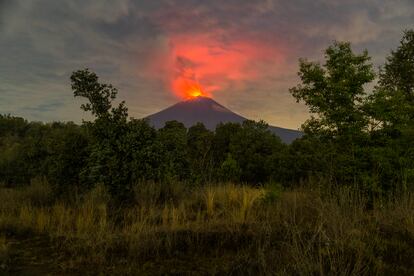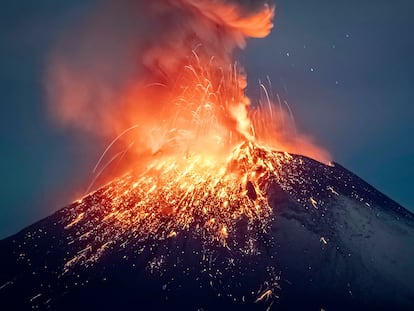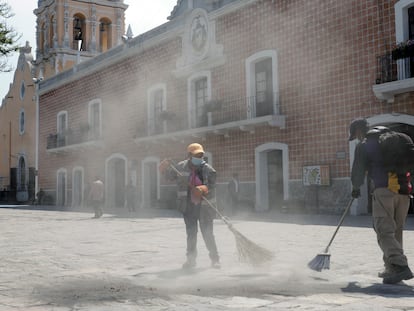The myths and the truth about the birth of a new volcano in Mexico City
Hugo Delgado Granados, researcher and specialist in volcanology at UNAM, clears up the main concerns about the supposed formation of a volcano south of the capital


The soil of Mexico City serves as a permanent reminder that we inhabit a geologically active planet. Founded on the basin of an ancient lake, where the soft floor multiplies the shocks of the earthquakes from the Pacific coast like nowhere else in the world, the capital also coincides with the Neovolcanic Axis, a strip that crosses the country from the Pacific to the Gulf and concentrates the majority of active volcanoes and the highest mountains in the national territory.
Last week, the news that a group of experts at the National Autonomous University of Mexico (UNAM) predicted the formation of a new volcano south of Mexico City flooded social networks with reactions of all kinds. Between memes and different versions about where and when the new volcano will arise, the University released a statement to try to stop the speculation.
“It is a fact that one day a new volcano will be born in the south of Mexico City, but whether we cause uncertainty, fear or calm depends on how we say it,” explains Hugo Delgado Granados, a researcher at the Department of Volcanology of the Institute of Geophysics of the UNAM. Along with other colleagues, Delgado has dedicated a good part of his scientific work to studying the Chichinautzin Volcanic Field, a region located in the south of the capital where tectonic conditions have favored the emergence of at least 220 monogenetic volcanoes, a class of smaller volcanoes that are born and erupt only once before finally going out.
“On the one hand, we have well-known central volcanoes such as Popocatépetl or the Pico de Orizaba, but on the other there are wide regions known as active monogenetic volcanic fields, which have erupted in the last 10,000 years,” he explains. “In the south of the City there is a monogenetic volcanic field that we know as Chichinautzin. If we see satellite images, we will notice that in this area there are many small volcanoes, and each one was formed by independent events of magma ascent,” says the expert.
Where could the new volcano be born?
Unlike large volcanoes with well-defined duct systems and craters, the soil that forms the Chichinautzin Volcanic Field makes the entire area a veritable minefield. On their way to the surface, magmas and gases break through faults and fractures in the area, finding new conduits with each eruptive event. Since fault zones are often covered in ash and lava remains that make them impossible to identify with the naked eye, one of the great challenges for experts is predicting where the next volcano could be born. “In monogenetic volcanic fields like Chichinautzin we have the three questions: where, how and when [a new volcano will arise], because in large volcanoes we already know where,” Delgado explains.
The area, which crosses densely populated areas in Mexico City, Morelos and the State of Mexico, extends from the extreme south of the capital, on the border of the Xochimilco, Tlalpan and Milpa Alta municipalities, to the Cuernavaca Valley in Morelos. From east to west, it ranges from the foot of Popocatépetl to the outskirts of Toluca. The key geographic landmark to understand the scope of the Volcanic Field is Xitle, the last volcano that was born in Chichinautzin approximately 2,000 years ago. Its eruption, the most direct precedent in the study of the activity of the Volcanic Field, caused lava flows that extended for more than 300 square kilometers and buried the ancient pre-Hispanic city of Cuicuilco, the most important urban center in the Valley of Mexico at the time.
In 2008, Delgado proposed a new method to try to predict the fault zones where the next volcano could be born. From the measurement of carbon dioxide present in the subsoil, an indicator of the most active faults in the region, the specialist intends to estimate the areas that “could be used by rising magmas to reach the surface” and therefore the places most likely to host the next eruption. Despite the difficulty in forecasting the site, Delgado is emphatic that only the extreme south of the capital is part of the Volcanic Field. In the rest of the city, there are no conditions for a volcano to be born: “If in the center of the Valley of Mexico there are earthquakes, it is practically impossible for a volcano to arise. Could one pop up in the Zócalo? No, because the geological background that allows the rise of magma and favors the creation of new volcanoes does not exist in the central zone of the Valley of Mexico. The conditions exist to the south of Xitle,” affirms the specialist.
When could the new volcano arise?
From the birth and the eruption of Xitle, Delgado and his colleagues have tried to estimate the Volcanic Field’s rest period, that is, the period between the end of one eruption and the beginning of the next. In 1988, the volcanologist analyzed the historical information of the Popocatépetl, one of the best-monitored volcanoes on the planet, to predict when it would awaken from its dormancy. Delgado estimated that the volcano’s rest period was approximately 70 years and, therefore, explosive activity should resume around 1997. The forecast did not fail. In December 1994, the Popo began a new eruptive phase, causing the first evacuation of the surrounding towns in the modern era.
“The calculations were not bad, but there was a lot of very good information about it,” he explains, comparing the situation with that of the Chichinautzin Volcanic Field, whose last eruption, that of Xitle, offers little information that allows the prediction of a new volcano. “What we need is to know the age at which each of the eruptions of the almost 300 volcanoes in the south of the City occurred. We know the age of several of them, but the information is still very scarce.” With the data available so far, the scientific consensus estimates that the birth of a new volcano in Chichinautzin ranges between 800 and 1,200 years, a range that rises to 1,500 years with the use of another data set. Taking into account that the Xitle eruption occurred between 1,700 and 2,000 years ago, Delgado concludes that more information is needed to produce a more accurate forecast.
A series of warnings
If a new monogenetic volcano began to emerge at this time, the signs prior to its appearance would be clear. The first manifestations, the light and increasingly frequent earthquakes, would be detected by the stations of the National Seismological Service. Mexican geologists know the ins and outs of a volcano’s birth firsthand. In 1943, the State of Michoacán witnessed the birth of Paricutín, a monogenetic volcano that arose in the Michoacán-Guanajuato Volcanic Field, whose slow but relentless lava flows buried the towns of Paricutín and San Juan Parangaricutiro. “These phenomena [the birth of volcanoes] are premonitory events, earthquakes and gas emissions that allow us to identify that a new body of magma is rising,” says the expert. “The history of the Paricutín eruption was very well documented, and at least a year beforehand, earthquakes began in the region. As time progressed, the frequency and recurrence of the earthquakes gradually increased until they became very evident, all before the eruption began.”
The researcher makes a new call for calm. “There are people who are alarmed that a volcano will arise overnight, and that is not possible,” he says, dispelling the doubts and listing the scientific certainties: “At the moment, we do not have any evidence that it is happening. What we know is that in the south of the city there is an active monogenetic volcanic field and that there is a probability that in the future, we do not know when, a new volcano may be produced.”
Sign up for our weekly newsletter to get more English-language news coverage from EL PAÍS USA Edition
Tu suscripción se está usando en otro dispositivo
¿Quieres añadir otro usuario a tu suscripción?
Si continúas leyendo en este dispositivo, no se podrá leer en el otro.
FlechaTu suscripción se está usando en otro dispositivo y solo puedes acceder a EL PAÍS desde un dispositivo a la vez.
Si quieres compartir tu cuenta, cambia tu suscripción a la modalidad Premium, así podrás añadir otro usuario. Cada uno accederá con su propia cuenta de email, lo que os permitirá personalizar vuestra experiencia en EL PAÍS.
¿Tienes una suscripción de empresa? Accede aquí para contratar más cuentas.
En el caso de no saber quién está usando tu cuenta, te recomendamos cambiar tu contraseña aquí.
Si decides continuar compartiendo tu cuenta, este mensaje se mostrará en tu dispositivo y en el de la otra persona que está usando tu cuenta de forma indefinida, afectando a tu experiencia de lectura. Puedes consultar aquí los términos y condiciones de la suscripción digital.
More information
Archived In
Últimas noticias
Most viewed
- Sinaloa Cartel war is taking its toll on Los Chapitos
- Oona Chaplin: ‘I told James Cameron that I was living in a treehouse and starting a permaculture project with a friend’
- Reinhard Genzel, Nobel laureate in physics: ‘One-minute videos will never give you the truth’
- Why the price of coffee has skyrocketed: from Brazilian plantations to specialty coffee houses
- Silver prices are going crazy: This is what’s fueling the rally










































